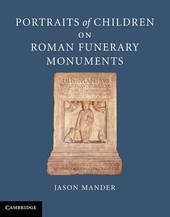
|
Portraits of Children on Roman Funerary Monuments
Hardback
Main Details
| Title |
Portraits of Children on Roman Funerary Monuments
|
| Authors and Contributors |
By (author) Jason Mander
|
| Physical Properties |
| Format:Hardback | | Pages:411 | | Dimensions(mm): Height 264,Width 225 |
|
| Category/Genre | Human figures depicted in art |
|---|
| ISBN/Barcode |
9781107001022
|
| Classifications | Dewey:726.80937 |
|---|
| Audience | | Professional & Vocational | |
|---|
| Illustrations |
130 Halftones, unspecified
|
|
Publishing Details |
| Publisher |
Cambridge University Press
|
| Imprint |
Cambridge University Press
|
| Publication Date |
18 October 2012 |
| Publication Country |
United Kingdom
|
Description
Drawing on hundreds of tombstones from Rome, Italy and the Western provinces, this study assesses how parents visualised childhood. By considering the most popular funerary themes and iconographic models, it emphasises both the emotional and social investment placed in children, bringing to the fore many little-known examples. From Britannia to Dacia, Aquitania to Pannonia, it highlights the rich artistic diversity of the provinces and shows that not all trends were borrowed from the capital. With a wide range of social groups in evidence, including freedmen, soldiers and peregrini, it also considers the varying reasons which underlay child commemoration and demonstrates the importance of studying the material in context. Amply supported by a catalogue of examples and over a hundred images, it will be essential reading for anyone working on Roman childhood or family studies.
Author Biography
Jason Mander is a Junior Research Fellow at Worcester College, Oxford. This is his first book.
Reviews'Mander has produced a study of Roman childhood that is exemplary not only for the physical research that has gone into documenting this far-flung body of monuments but also for his rigorous, wide-ranging, and sober analysis of that corpus within its broader visual traditions and social-historical contexts. This is a book that any scholar with an interest in ancient childhood, the family, and social history will profit from reading.' Sinclair Bell, American Journal of Archaeology
|